Winter times bring beautiful scenery of white powdered driveways and snowmen popping up to greet you around every corner. But it also wreaks havoc on driveways, sidewalks, and roads as the icy surface creates an inconvenience and danger hazard that needs to be dealt with.
Ice is a great way to melt ice that has formed on roads, driveways and footpaths but how exactly do you melt ice with salt?
To melt ice with salt first remove the top layer of snow using a shovel or plough. Then spread salt evenly over the ice. Use a light spread in warmer temperatures around 30ºF/-1ºC and more salt as the temperatures get lower. Leave for 20-30 minutes before walking or driving on the surface or using a shovel to remove excess ice.
Knowing exactly how to melt ice effectively with salt will get your the best result in the quickest amount of time and will also avoid you wasting money by using more salt than you need to.
How To Melt Ice With Salt On A Driveway?
When temperatures drop and ice starts forming on driveways and roads, it's time to bring out the de-ice bags and salt those driveways and sidewalks.
Preparing your driveway or footpath and then applying the right salt in the right quantity is essential if you want a good result and you want to protect the concrete.
1. Prepare The Area
Using your snow shovel, remove the snow on your driveway to expose the bare concrete or the ice on the concrete.
You don't want to apply salt directly onto the snow, especially if the snow is thick. The ice will melt the snow and then wash away and it won't melt the underlying ice as effectively.
So make sure to remove the top layer of snow before applying your ice.
2. Choose The Right Type of Salt
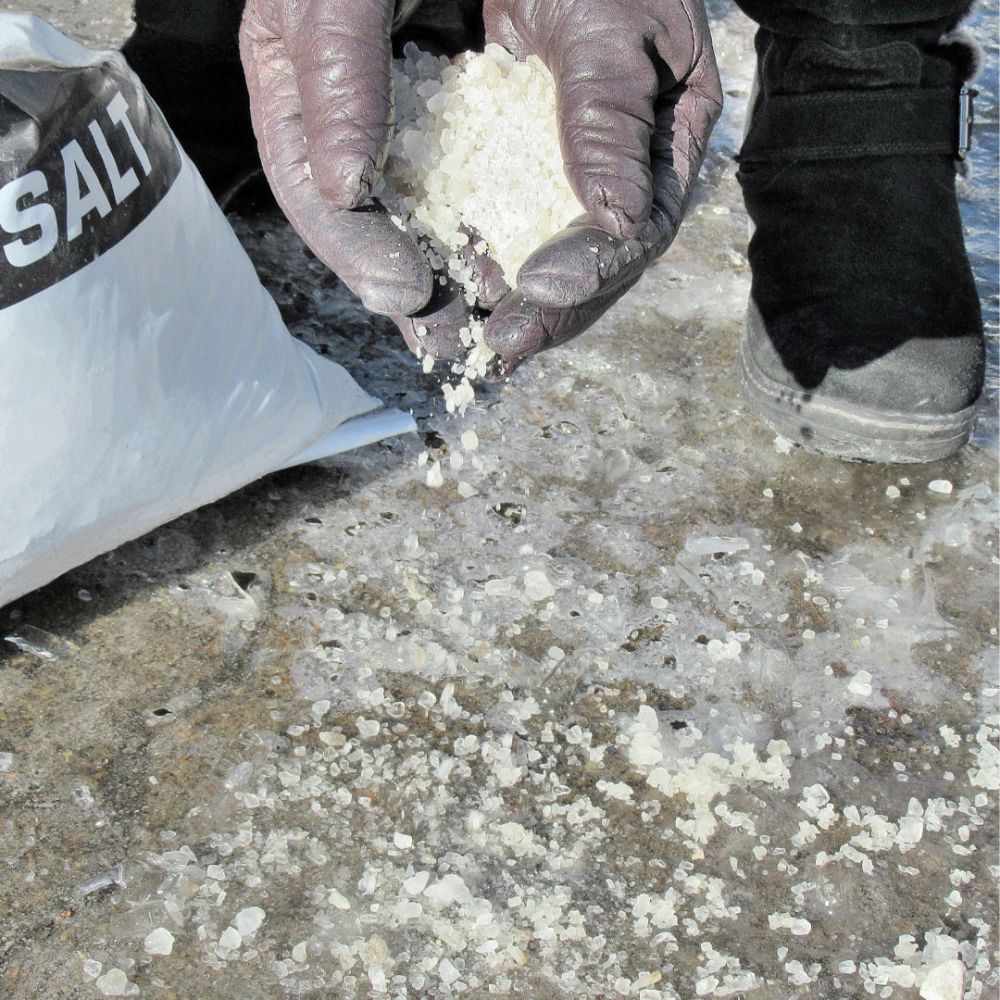
While household salt/rock salt (sodium chloride) is the most common type used for deicing it's not always the best choice.
The issue mainly comes from the salt melting the ice during the day then that water seeping into your concrete and then refreezing overnight.
This applies a great deal of pressure to the inside of your concrete and destroys it quite quickly.
If you're using salt to melt ice on asphalt you're fine but if you have concrete and expect refreezing during the evenings then calcium chloride is usually recommended as one of the best alternatives to salt for melting ice.
Spread The Salt Evenly Over The Ice
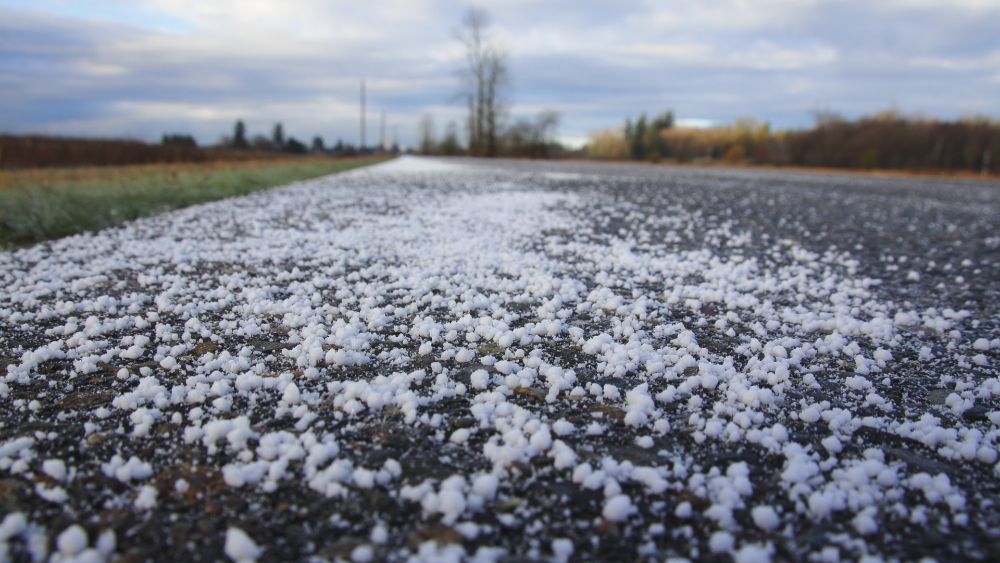
Using a small handheld scoop, sprinkle rock salts across the concrete or ice. Do not overdo it – use the method less is more.
You can also make use of garden fertilizer spreaders, either handheld ones or small wheeled-based ones, to evenly disperse the salt across your driveway.
For small amounts you can even use your hands and spread it over the ice. However, gloves are definitely recommended.
Over time your ice melt can clump together so you'll need to unclump your ice melt before spreading it over your driveway or footpath. To stop clumping from happening store your ice melt in an airtight container in a cool dry place. This will also stop liquid leaking from your ice melt bag – making a huge mess on your garage floor.
The higher the temperature compared to the type of salt you're using the less salt you actually need.
While calcium chloride is more expensive than normal rock salt, because it works down to such low temperatures only a small amount is needed.
This can make it more cost effective overall even though you pay more per pound for the product.
See the video below talking about some of the different salt products and what the safest one for concrete is.
Allow Time For The Salt To Melt The Ice
Allow about 15-30 minutes for the ice to melt if you are spreading it over a layer of ice. It doesn't take ice melt long to start working however the exact time will vary based on type of salt, outside temperature, amount of salt used and the thickness of the ice layer.
Once the ice melts and runs off, any surplus of salt left on your driveway should be cleaned up to prevent damage to your concrete.
And as to what salt to use depends on how cold the temperature is in your area.
Do You Salt Your Driveway Before Or After It Snows?

There is no absolute rule in suggesting the best time to salt your driveway. If you miss the broadcast and wake up to find a layer of ice covering your driveway before you got to salt it, then you can just as easily sprinkle a layer over it.
Start by using your snow shovel to remove the snow and sprinkle the salt by hand or use a small fertilizer spreader to evenly disperse the salts across your driveway with much less effort and fuss.
Salting your driveway before the snow falls and the icy temperature sets in to form a layer of dangerous slippery ice can sometimes save you time.
However, this is only going to be true if the evening temperatures don't drop below the minimum working temperature of your salt. This is because salt melts ice (or stops ice forming) by lowering its freezing point. This only works down to certain temperatures though.
Regular table salt can work down to approximately 16ºF/-9ºC but calcium chloride can work down to temperatures as low as -25ºF/-31ºC.
Throwing salt above ice works well when there is high friction on the surface, such as vehicle traffic or pedestrian traffic, as this disperses the salty puddles along to other areas creating a faster dilution of the ice.
At What Temperature Does Road Salt Stop Working?
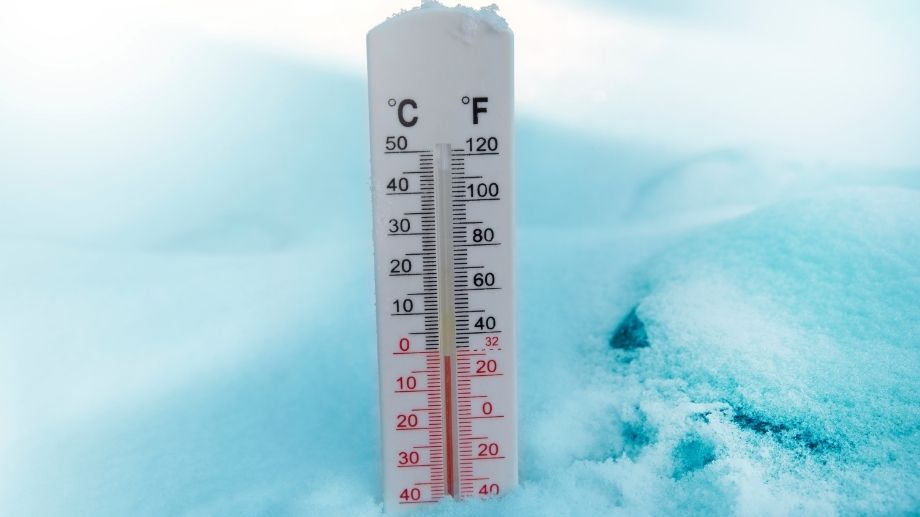
Road salts (sodium chloride), also known as rock salts, are unpurified versions of table salts that make them appear grey or brown due to their mineral impurities. Sodium hexacyanoferrate and sugar prevent the salt from caking in transport and allow the trucks to deliver and spread it across the roads easily.
Road salts are an effective and affordable option for deicing roads and driveways. However, there is a limit to how well it works depending on the time of day and the temperature.
Road salts work great during the daylight and are generally recommended to temperatures as low as 16ºF/-9ºC and if the temperatures do not drop below 10°F during nighttime. When temperatures plummet south of that reading, road salts become ineffective.
Road salts can lower the freezing point of water, creating a freezing point depression, the efficiency with which one pound of salt can melt ice is dependent on the temperatures. The same is true for road salt, table salt and kosher salt. It's all made of sodium chloride.
One pound of salt can efficiently melt 46 pounds of ice if the temperatures are 30°F/-1ºC. But as the temperature drops to 20°F/-7ºC, one pound of road salt will only be effective on about eight pounds of ice.
At 15°F/-9ºC road salt starts to become very ineffective and another salt like calcium chloride should be used instead.
Sand is also a great option for colder weather. Sand does not melt ice but it adds traction to the ice so people and vehicles are less likely to slip.
Does It Matter What Salt You Use To Melt Ice?
Any salt will work on deicing your driveway, cooler box, freezer, or pavement, but each salt has its pros and cons and efficiency.
If you run out to your hardware store and the rush of ice melts has left the shelves bare, then know that using table salt is just as effective. As I previously mentioned, road salt and table salt are pretty much the same, apart from road salts not being purified for human consumption.
Salt grain size will affect how quickly the ice melts – but not to a huge degreee. Table salt is fine and has more surface area than road salts, which are coarse granules and have a smaller surface area.
But I wouldn't recommend using your table salt as a long-term deicer, as this is more expensive than its unpurified version of rock salts.
Kosher salt is another form of salt that can be used for deicing but will take longer to melt the ice as this is a very coarse crystal with a much smaller surface area; the plus point to its coarseness is that it is much easier to disperse over larger areas.
How To Melt Ice With Salt In A Bowl Or Cooler
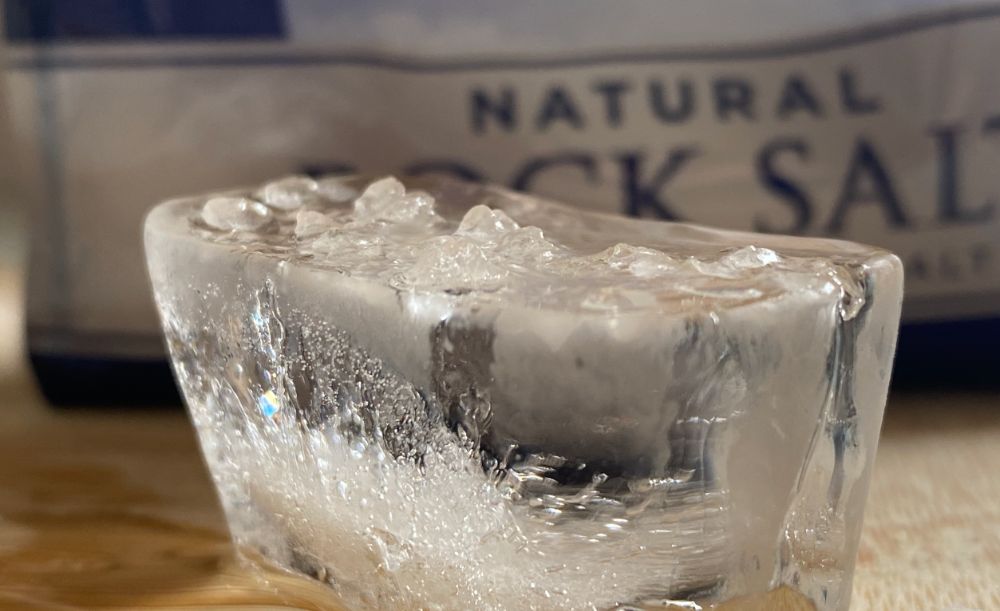
Adding some table salts or rock salts to a bowl full of ice is a great way to quickly chill that bottle of vino on your picnic, or perhaps you just bought some beers for the game but don't have time to chill them.
Salt is also used to make ice cream by quickly melting ice and making it cold enough to freeze the ice cream.
Adding ice to a bowl or cooler will melt your ice faster, but in turn, it will chill your drinks down considerably faster than if you place it in the fridge. If you want to chill drinks in a cooler faster then salt is going to help you do that.
When the ice melts due to contact with the salt, ice water is released as the freezing point is lowered, it drops the temperature inside the bowl or cooler, and the ice water in contact with the bottle chills the drinks in as little as 4-6 minutes.
How Much Salt Do You Need To Melt Ice?
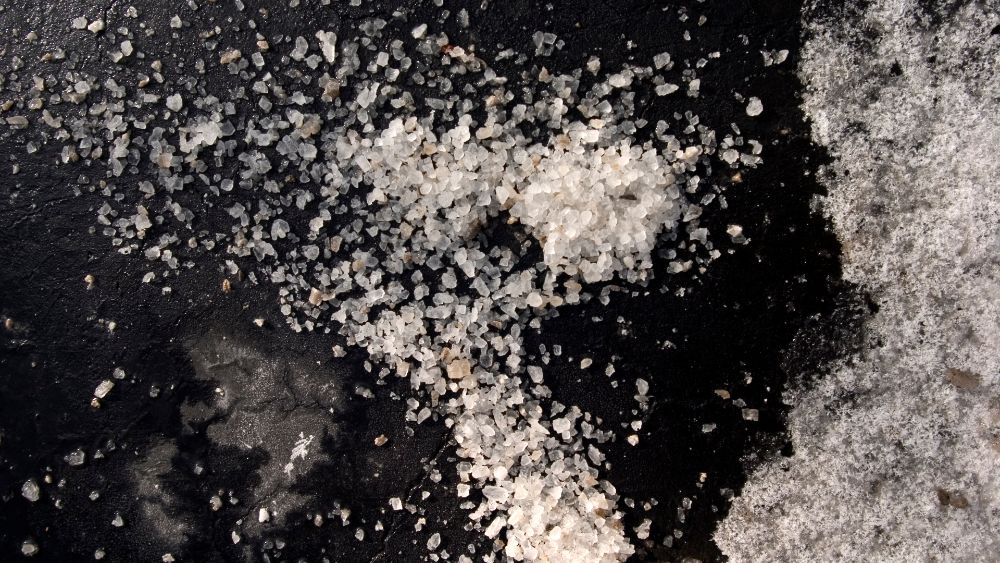
When winter finally sets in, we see icy sidewalks and driveways with roads hiding a layer of danger. To this, we respond by throwing salts as a means to deice the areas, but more salt doesn't mean a quicker ice melt. In fact, it's a waste of money and harmful to our environment.
So how much salt do you need? When unsure, use the phrase “less is more” and reapply salt in small quantities rather than over-salting.
Think of when you're cooking and how you would apply salt, the same thing for your driveway and roads.
As a general rule, 12 ounces of salt, enough to fill a coffee mug, is sufficient to deice a 20-foot driveway or ten squares of paving.
Using snow shovels and scoops can be a way of spreading the salt. For a more effective way of spreading your salt, use a garden spreader, either a handheld one or one on wheels; this method of spreading salt allows you better control.
After the ice melts and there are still crystals lying around, you have used too much and should use less the next time. Don't leave the crystals lying around as this can be environmentally hazardous to soil and plants; sweep up the remaining crystals.
Is Salt The Fastest Way To Melt Ice?
Salt is a more cost-effective way of deicing driveways and roads and is the fastest way, too, due to its chemical make-up of two ions, sodium and chloride. But rock salts have their limitations and will only work down to temperatures of 16ºF/-9ºC.
Calcium chloride is one of the fastest and most effective ways to melt salt. It works down to temperatures as low as -25ºF/-31ºC but at warmer temperatures it works extremely effectively to melt ice quickly.
There are other options that you can use depending on your needs. Whether the weather is too cold for salt or you are looking for a more environmentally friendly alternative, there are other solutions for you.
Conclusion
When winter arrives, it brings along the beauty it offers with the hazards of icy conditions. Salt is one of the most popular forms of deicing driveways, sidewalks, and roads, but some alternatives can be more cost-effective and environmentally friendly depending on the conditions.



